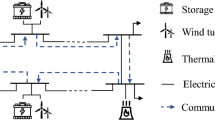Abstract
Power systems have been dramatically changing with cutting-edge information technologies. The new power system infrastructure has evolved and has been studied by many institutes and companies. Future power systems are bound up quietly with customer-side activities such as real-time pricing and distributed generators (DGs). To deploy those services on the power system, independent and hierarchical communication network architecture is proposed by information hiding and suppressing data exchange in this paper. The function of self-healing and resist attack will be easily implemented by this proposed network. This paper especially focuses on communication bandwidth and topology for power distribution areas as a backbone network for DGs.

















Similar content being viewed by others
References
Smith TM, Muschlitz BA, Goodman FR, McDermott TE (2007) Advanced feeder design for distributed generation. In: IEEE power engineering society general meeting, pp 1–6
Chowdhury S, Chowdhury SP, Crossley P (2009) Microgrids and active distribution networks. The Institution of Engineering and Technology, pp 2–3
Yang Hyo-Sik, Raza Ali, Park Min-Woo, Kim Sang-Sig, Jang Hyuk-Soo, Lee Myung-Ho, Kwon Dong-Seop, Jang Byung-Tae (2009) Gigabit ethernet based substation. J Power Electron 9(1):100–108
Skiei T, Johannessen S, Brunner C (2002) Ethernet in substation automation. IEEE Control Syst Mag 22(3):43–51
IEC 61850-5 (2013) Communication networks and system in substations part 5: communication requirements for functions and device models
Sidhu TS, Injeti S, Kanabar MG, Parikh PP (2010) Packet scheduling of goose messages in IEC 61850 based substation intelligent electronic devices (IEDs). In: IEEE power and energy society general meeting, pp 1–8
Sidhu TS, Yin Y (2007) Modeling and simulation for performance evaluation of IEC 61850-based substation communication systems. IEEE Trans Power Deliv 22(3):1482–1489
Korea Electric Power Cooperation (2009) Statistics of electric power inKorea. http://www.kepco.co.kr/eng/>investor. Relations > IR> Investor Resources > Statistics of Electricity > Statistics of Electric Power in Korea
Golany B, Roll Y, Rybak D (1994) Measuring efficiency of power plants in Israel by data envelopment analysis. IEEE Trans Eng Manag 41(3):291–301
Kleinrockt L (1976) Queueing systems, volume II : computerapplicaitons. A Wiley-Interscience Publication, New York, pp 277–290
Aggarwal A, Kunta S et al (2010) A proposed communications infrastructure for the smart grid. Innov Smart Grid Technol (ISGT), pp 1–5
Garner G (2010) Designing last mile communications infrastructure for intelligent utility networks (smart grid). In: The conference of the electric power supply industry (CEPSI)
Overman TM, Sackman RW (2010) High assurance smart grid: smart grid control systems communications architecture. In: First IEEE international conference on smart grid communications (SmartGridComm), pp 19–24
Meador B (2008) A survey of computer network topology. http://www1.cse.wustl.edu/~jain/cse567-08/ftp/topology.pdf. Accessed Apr 2015
Oi H, Ranganathan N (1998) A comparative study of bidirectional ring and crossbar interconnection networks. In: Proceedings of the 1998 international conference on parallel and distributed processing techniques and applications (PDPTA’98), Las Vegas, pp 883–890
IEC 61850-3 (2013) Communication networks and systems in substations part 3: general requirement
IEC 60870-4 (1990) Telecontrol equipment and systems part 4: performance requirements
Roberts NH, Vesely WE, Haasl DF, Goldberg FF (1981) Fault tree handbook. NUREG-0429m US Nuclear Regulatory Commission, Washington, DC
Scheer GW, Dolezilek DJ (2007) Selecting, designing, and installing modern data networks in electrical substations. In: Proceedings of the ninth annual western power delivery and automation conference, Spokane
Gugerty M, Jenkins R, Dolezilek DJ (2006) Case study comparison of serial and ethernet digital communications technologies for transfer of relay quantities. In: Proceedings of the 33rd annual western protective relay conference, Spokane
http://datainterfaces.com/FIB1-T1R-T1-to-fiber-convertermultimode-2Km.aspx. Accessed Apr 2015
http://www.scribd.com/doc/376112/Cisco-Data-Sheet. Accessed Apr 2015
Amin M, Schewe PF (2007) Preventing blackout. Sci Am 296:60–67
Silver Spring Network (2013) White paper, smart grid security myths vs. reality. http://www.silverspringnet.com/pdfs/SilverSpring-Whitepaper-SmartGridSecurity-MythsReality.pdf. Accessed Apr 2015
Kim M, Metzner JJ (2010) A key exchange method for intelligent electronic devices in distribution automation. IEEE Trans Power Deliv 25(3):1458–1464
Acknowledgments
This work was supported by the Power Generation and Electricity Delivery of the Korea Institute of Energy Technology Evaluation and Planning (KETEP) grant funded by the Korea government Ministry of Trade, Industry and Energy (No. 2013101050165G).
Author information
Authors and Affiliations
Corresponding author
Rights and permissions
About this article
Cite this article
Kim, M., Kim, Y. & Myoung, N. A multi-level hierarchical communication network architecture for distributed generators. Electr Eng 97, 303–312 (2015). https://doi.org/10.1007/s00202-015-0332-7
Received:
Accepted:
Published:
Issue Date:
DOI: https://doi.org/10.1007/s00202-015-0332-7




